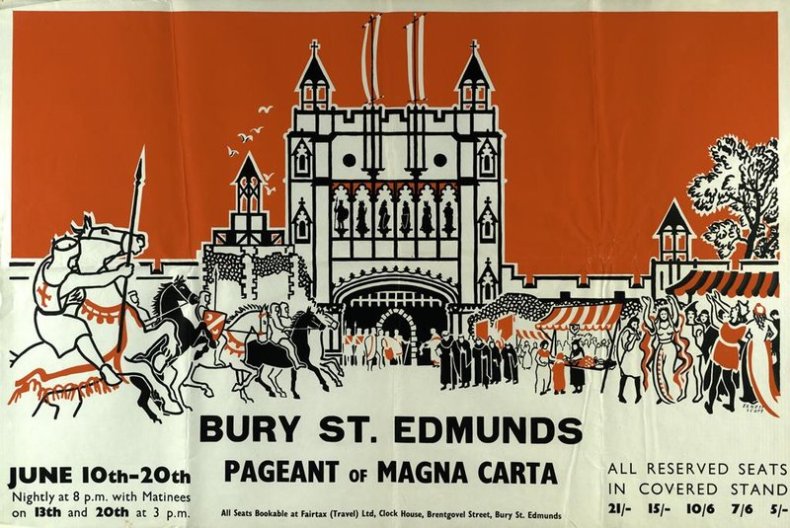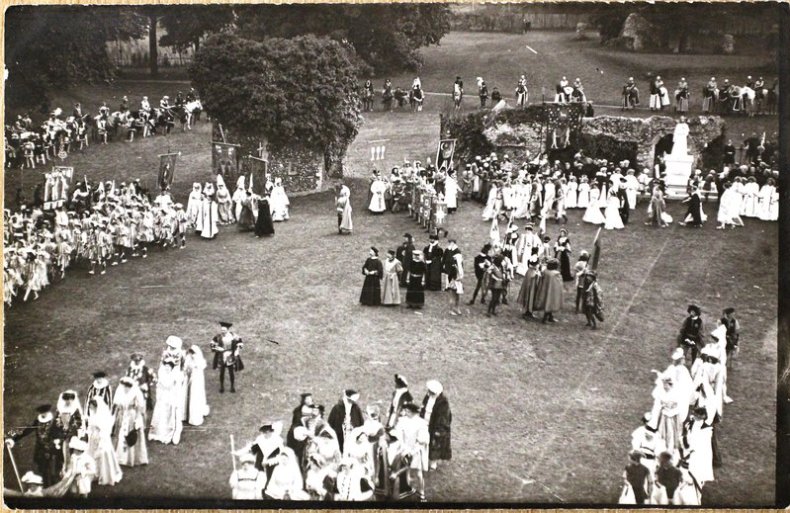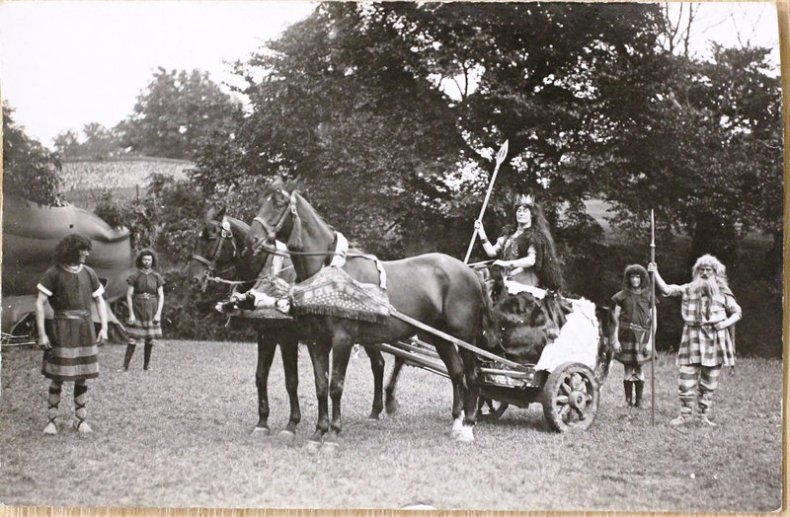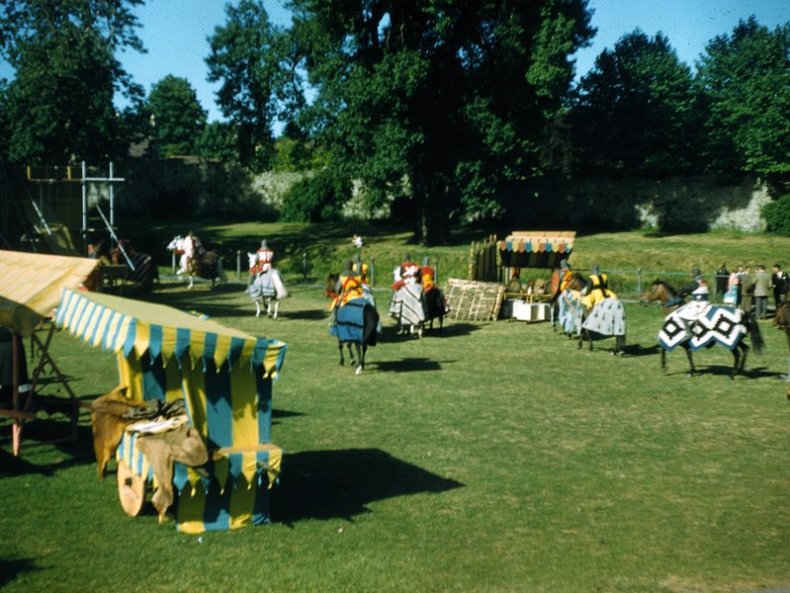Sometimes the academy can be a drab corner of the world, its inhabitants gasping for breath among drifts of heavily footnoted papers. But then, when we all most need it, along comes a well-funded project (under the aegis of the Arts and Humanities Research Council) taking a resonant journey into cultural anthropology.
‘The Redress of the Past: Historical Pageants in Britain, 1905–2016’ presents itself via a welcoming website inviting the public to add information and blogs about the country-wide plethora of earnest, wacky initiatives that constituted ‘pageant-fever’ in earlier, more technologically innocent, decades. Places across the country seized on a past event of local or national significance (often aggrandising it or adding spurious details) and organised amateur productions offering ‘national costume drama on a grand scale’.

Poster advertising the Bury St Edmunds Pageant of Magna Carta, 1959. By kind permission of the Suffolk Record Office, Bury St Edmunds branch
Their range, scope, and psychological undercurrents attracted sharp-penned novelists such as Virginia Woolf and Richmal Crompton, released the repressed thespian abilities of clerics and mayors, and invited the forgotten talents of local composers, designers, and dramatists out of the civic woodwork. These were enormous events in quotidian local life – usually one-off productions, remembered for decades and now, thanks to this project, reappearing from the archives.
Danny Boyle’s thrilling London 2012 Olympic opening show may have epitomised the highest achievement in the genre to date, but the three pageants held in Bury St Edmunds, in 1907, 1959, and 1970, ran the gamut of this kind of entertainment, up to and including their limitations.

A typical crowd scene in a postcard of the seventh episode in 1907. By kind permission of the St Edmundsbury Heritage Service
There was obvious dramatic potential of the meeting held in St Edmundsbury in late 1214 and convened by the Barons in the Abbey Church, during which King John was compelled to accept the Charter of Liberties, to become the Magna Carta the following year. In 1907 ambitious Bury citizens invited the emperor of pageants, Louis Napoleon Parker – whose first effort, in Sherborne, Dorset, two years earlier had been acclaimed – to mastermind a pageant in the abbey ruins. That summer, 1,800 performers (a large slice of the town’s population), dressed in costumes of their own making, accompanied by choir and orchestra, staged a three-hour spectacular, following the fortunes of the town from the Romans, via (imaginatively inserted) Boadicea, and then pressing on to ‘a whirlwind exercise in local history’. There were 11 performances. It was presented as a properly communal endeavour, in which individual and collective effort flew in the face of the prejudices of Edwardian class-ridden society (even if major roles did fall to key civic and church grandees). In addition, in Parker’s view, the event had raised great local interest in the history, antiquities, and architecture of their remarkable town – a challenge to unwelcome modernising tendencies.

Boadicea in a postcard of the pageant in 1907. By permission of the St Edmundsbury Heritage Service
It was still a warm, if very distant, memory when it was decided to stage a Magna Carta pageant in 1959, now with a dash of humour and some carefully planted allegory, as well as television-friendly lights and amplification. Here I must declare an interest. I was there and firmly believe that I took part, although, checking with two contemporaries, they have no such memory. So perhaps we did attend, but rather as child audience members, given a cloak or some medieval garb as a reward for a longish bus journey, but I was there – at least for one performance.
Episodes from 1907 were restaged, extending beyond the mid 16th century and now suitably modernised. Canon Richard Tydeman, already the author of Woodbridge’s Coronation Pageant, wrote it. A thousand people performed, under the direction of Christopher Ede, Parker’s successor as national pageant-supremo. Again the event was successful and profits vested in the Abbey Gardens.
In 1970 came a pageant-play ‘Edmund of Anglia’ but now the event was tainted by a series of bitter disputes in which, sadly, the homespun and the enjoyable gave way to a suspicion of commercialisation and disturbing strains of prejudice emerged in the telling of history. Now the pageant had become real life.

Crowd scene, 1959. By kind permission of Margaret Charlesworth

‘National costume drama on a grand scale’
Horace Barker as King John (postcard). By permission of the St Edmundsbury Heritage Service
Share
Sometimes the academy can be a drab corner of the world, its inhabitants gasping for breath among drifts of heavily footnoted papers. But then, when we all most need it, along comes a well-funded project (under the aegis of the Arts and Humanities Research Council) taking a resonant journey into cultural anthropology.
‘The Redress of the Past: Historical Pageants in Britain, 1905–2016’ presents itself via a welcoming website inviting the public to add information and blogs about the country-wide plethora of earnest, wacky initiatives that constituted ‘pageant-fever’ in earlier, more technologically innocent, decades. Places across the country seized on a past event of local or national significance (often aggrandising it or adding spurious details) and organised amateur productions offering ‘national costume drama on a grand scale’.
Poster advertising the Bury St Edmunds Pageant of Magna Carta, 1959. By kind permission of the Suffolk Record Office, Bury St Edmunds branch
Their range, scope, and psychological undercurrents attracted sharp-penned novelists such as Virginia Woolf and Richmal Crompton, released the repressed thespian abilities of clerics and mayors, and invited the forgotten talents of local composers, designers, and dramatists out of the civic woodwork. These were enormous events in quotidian local life – usually one-off productions, remembered for decades and now, thanks to this project, reappearing from the archives.
Danny Boyle’s thrilling London 2012 Olympic opening show may have epitomised the highest achievement in the genre to date, but the three pageants held in Bury St Edmunds, in 1907, 1959, and 1970, ran the gamut of this kind of entertainment, up to and including their limitations.
A typical crowd scene in a postcard of the seventh episode in 1907. By kind permission of the St Edmundsbury Heritage Service
There was obvious dramatic potential of the meeting held in St Edmundsbury in late 1214 and convened by the Barons in the Abbey Church, during which King John was compelled to accept the Charter of Liberties, to become the Magna Carta the following year. In 1907 ambitious Bury citizens invited the emperor of pageants, Louis Napoleon Parker – whose first effort, in Sherborne, Dorset, two years earlier had been acclaimed – to mastermind a pageant in the abbey ruins. That summer, 1,800 performers (a large slice of the town’s population), dressed in costumes of their own making, accompanied by choir and orchestra, staged a three-hour spectacular, following the fortunes of the town from the Romans, via (imaginatively inserted) Boadicea, and then pressing on to ‘a whirlwind exercise in local history’. There were 11 performances. It was presented as a properly communal endeavour, in which individual and collective effort flew in the face of the prejudices of Edwardian class-ridden society (even if major roles did fall to key civic and church grandees). In addition, in Parker’s view, the event had raised great local interest in the history, antiquities, and architecture of their remarkable town – a challenge to unwelcome modernising tendencies.
Boadicea in a postcard of the pageant in 1907. By permission of the St Edmundsbury Heritage Service
It was still a warm, if very distant, memory when it was decided to stage a Magna Carta pageant in 1959, now with a dash of humour and some carefully planted allegory, as well as television-friendly lights and amplification. Here I must declare an interest. I was there and firmly believe that I took part, although, checking with two contemporaries, they have no such memory. So perhaps we did attend, but rather as child audience members, given a cloak or some medieval garb as a reward for a longish bus journey, but I was there – at least for one performance.
Episodes from 1907 were restaged, extending beyond the mid 16th century and now suitably modernised. Canon Richard Tydeman, already the author of Woodbridge’s Coronation Pageant, wrote it. A thousand people performed, under the direction of Christopher Ede, Parker’s successor as national pageant-supremo. Again the event was successful and profits vested in the Abbey Gardens.
In 1970 came a pageant-play ‘Edmund of Anglia’ but now the event was tainted by a series of bitter disputes in which, sadly, the homespun and the enjoyable gave way to a suspicion of commercialisation and disturbing strains of prejudice emerged in the telling of history. Now the pageant had become real life.
Crowd scene, 1959. By kind permission of Margaret Charlesworth
Unlimited access from just $16 every 3 months
Subscribe to get unlimited and exclusive access to the top art stories, interviews and exhibition reviews.
Share
Recommended for you
The first classical building in Britain gets the modern treatment it deserves
The Queen’s House in Greenwich is steeped in so much history that curators have struggled to decide what to highlight. But now the problem seems to have been solved
It’s time to look at graffiti on its own terms
Graffiti is usually seen as art or vandalism, but the distinction is stopping us from seeing it for what it really is
Drinking scenes: the relationship between artists and alcohol
The Romantic association between creativity and alcohol has no foundation, but alcohol and its effects have proved a rich subject for artists